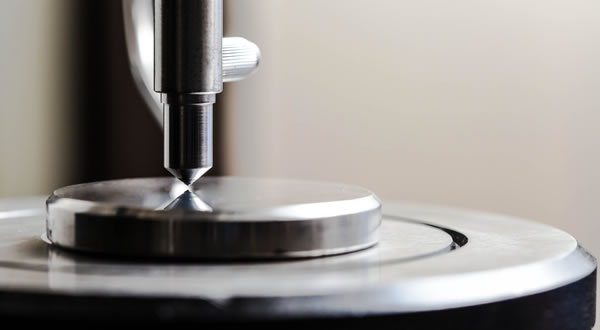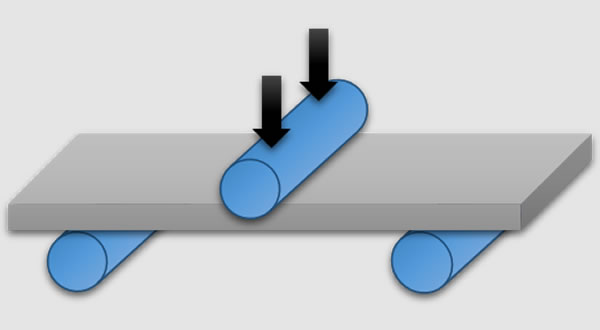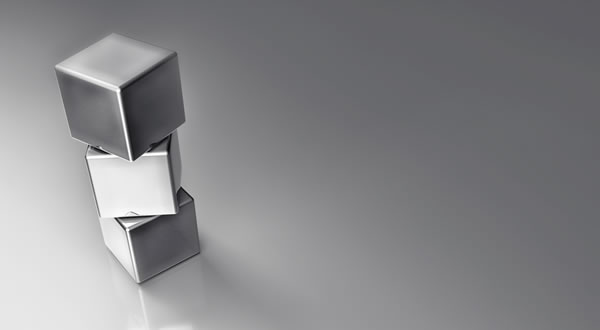Features of cemented carbide
What is cemented carbide?
In a wide sense, cemented carbide refers to composite alloys binding the hard grains of carbides, nitrides, or carbonitrides of IVa, Va or VIa metals in the periodic table with iron-based metal. In particular, WC-Co-based alloys are widely used due to their excellent characteristics, and, n general, cemented carbide is understood as WC-Co-based alloy. 1)
1High hardness

Hardness increases dramatically as tungsten binds with carbon, resulting in high abrasion resistance.
2High strength

It is high in transverse rupture strength (bending strength), and delivers high reliability against forces in bending direction.
3High rigidity

It has a high Young’s modulus (difficulty to bend), and excels in rigidity.
History of cemented carbide
While the history of the current cemented carbide goes back to the 1890s, the foundation for the current manufacturing method was established by K. Schroter in 1923, when he formed WC through the carbonization of W while reacting powders of W and C (carbon) in a hydrogen atmosphere, then added Co powder to the WC and sintered the mixture. In 1926, Friedlich Krupp in Germany industrialized cemented carbide in tools based on this technique, releasing products with the name Widia (Wie Diamant = like diamond). In 1928, the U.S. General Electric also released cemented carbide products, and research was begun by Toshiba, Sumitomo Electric Industries, and Mitsubishi Metal, each on their own, around 1928, to advance industrialization. Later it was found that alloys to which TiC, TaC, NbC and so forth was added, which have low reactivity against Fe, were better suited to steel cutting, and Krupp released the (WC-10% TiC-6%Co) alloy in 1931, establishing the foundation for cemented carbide as tools.
Then grain-size adjustment technology with addition of trace amounts of VC, TaC and so forth to WC was studied in a WC-Co₂-based system, creating particulate hard metal type H in 1929, and a high-toughness alloy was developed with the use of coarse-grain WC and increase in the amount of Co, leading to the introduction of 15% Co alloy in 1932. At present, various improvements have been made in cemented carbide, which is used in cutting, abrasion resistance, impact resistance, mining tools and so forth. In recent years, the development of methods to form hard film coating on the surface of cemented carbide using the chemical vapor deposition (CVD) method or physical vapor deposition (PVD) method, and the special cemented carbide for coating has advanced, contributing to dramatic progress in the characteristics of tools.1)
To see the whole table, scroll sideways.
| Composition(mass%) | Density (Mg/m3) |
Hardness HRA |
Transverse rupture strength (GPa) |
Young’s modulus (GPa) |
Thermal conductivity (W/m・K) |
|
|---|---|---|---|---|---|---|
| WC | Co | |||||
| 100 | ― | 15.7 | 92-94 | 0.3-0.5 | 720 | ― |
| 97 | 3 | 15.1-15.2 | 90-93 | 1.0-1.2 | 668 | 88 |
| 95 | 5 | 14.8-15.0 | 90-91 | 1.6-1.8 | 620 | 80 |
| 90 | 10 | 14.3-14.5 | 88-90 | 1.5-1.9 | 584 | 71 |
| 85 | 15 | 13.8-14.0 | 86-88 | 1.8-2.2 | 548 | ― |
| 80 | 20 | 13.1-13.3 | 83-86 | 2.0-2.6 | 500 | ― |
| 75 | 25 | 12.8-13.0 | 82-84 | 1.8-2.7 | 467 | ― |
| 70 | 30 | 12.3-12.5 | 80-82 | ― | ― | ― |
| ― | 100 | 8.9 | ― | ー | 179 | 71 |